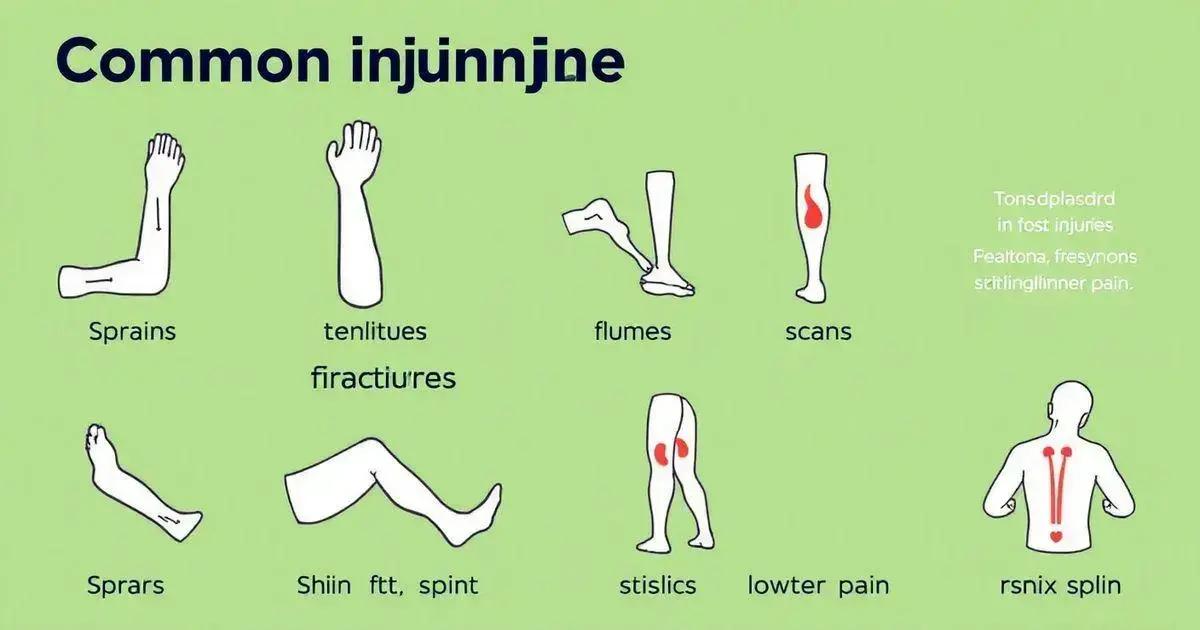Designing workouts around common injuries involves understanding the types of injuries, adjusting workout intensity, incorporating rehabilitation exercises, and implementing preventive measures to ensure safe and effective fitness routines while promoting recovery and reducing the risk of future injuries.
Injuries can significantly disrupt your fitness journey, making it essential to learn how to design workouts around common injuries. By applying specific strategies, you can continue exercising while facilitating recovery. This article delves into recognizing common injuries, adjusting workout intensities, incorporating rehabilitation exercises, and preventing future injuries, ensuring a safe and effective fitness approach.
Understanding Common Injuries

To effectively understand common injuries, it is essential to learn about the types and symptoms that can occur during workouts. Injuries often happen due to overuse, improper form, or inadequate warm-ups. Some of the most common injuries include:
1. Sprains and Strains
Sprains occur when ligaments are stretched or torn, typically in the ankle or knee. Strains are injuries to muscles or tendons and can affect areas like the back or hamstrings. Signs include pain, swelling, and limited motion.
2. Tendinitis
Tendinitis is the inflammation of a tendon, often seen in the elbow (tennis elbow) or shoulder (rotator cuff tendinitis). Symptoms include aching, stiffness, and increased pain during activity.
3. Fractures
Fractures involve a break in the bone and can range from minor stress fractures to severe breaks. Symptoms may include intense pain, swelling, and an inability to use the affected limb.
4. Shin Splints
This injury causes pain along the shin bone, commonly experienced by runners. It arises from repetitive impact on the hard surface, leading to inflammation of muscles and tendons.
5. Lower Back Pain
Lower back pain can result from poor form while lifting weights or lack of proper core strength. It’s vital to perform movements correctly to avoid undue stress.
By recognizing these injuries, individuals can create effective workout plans that prioritize safety and recovery. Understanding common injuries equips individuals with the knowledge to make informed decisions when designing their fitness routines.
Adjusting Workout Intensity

When designing workouts, adjusting workout intensity is crucial, especially when dealing with injuries. Managing how hard you push yourself ensures recovery while still benefiting fitness goals. Here are some methods to adjust your workout intensity:
1. Listen to Your Body
Pay attention to how you feel during and after workouts. If you’re experiencing pain beyond typical soreness, reduce your intensity. Ignoring your body’s signals can lead to worsening injuries.
2. Modify Exercises
Switching to lower-impact exercises can help decrease intensity. For example, if you usually run, consider brisk walking or cycling instead. These modifications allow for continued movement without adding extra strain.
3. Use Heart Rate Monitoring
Monitoring your heart rate can guide your intensity level. Aim for 50-70% of your maximum heart rate during workouts suitable for recovery. This range promotes fitness without excessive strain.
4. Incorporate Rest Days
Rest days are essential when adjusting intensity. They provide muscles with needed recovery time. Plan light activity or stretches on rest days to keep moving without overdoing it.
5. Gradual Progression
After recovering from an injury, slowly increase intensity. You might add weights or increase the duration of workouts little by little. This steady approach helps your body adapt without risking reinjury.
By effectively adjusting workout intensity, you can continue to improve your fitness while protecting yourself from further injuries. Always prioritize safety over speed in your workout regimen.
Incorporating Rehabilitation Exercises

Incorporating rehabilitation exercises into your workout routine is vital for recovery from injuries. These exercises can help restore function, improve strength, and prevent further damage. Here’s how to effectively integrate rehabilitative movements:
1. Focus on Targeted Areas
Identify which areas need rehabilitation. For instance, ankle sprains might require exercises focused on balance and strength. Tailoring exercises to your specific needs is essential for effective recovery.
2. Start with Basic Movements
Begin with simple, low-impact exercises that don’t strain the injured area. Examples include gentle stretching, isometric exercises, or resistance band workouts to strengthen surrounding muscles.
3. Gradually Increase Difficulty
As your strength and mobility improve, gradually increase the complexity of your rehabilitation exercises. You can add weights, resistance, or vary the type of movement while ensuring you’re not overly straining the affected area.
4. Include Flexibility and Mobility Work
Flexibility and mobility are crucial after an injury. Incorporate stretching and range-of-motion exercises to improve flexibility, which helps in recovery and prevents stiffness.
5. Consult a Professional
Working with a physical therapist or qualified trainer can help ensure you are doing the right exercises correctly. They can provide personalized recommendations and adjustments.
Incorporating rehabilitation exercises into your workouts allows for a smoother recovery process, enhancing overall performance and reducing the risk of future injuries.
Preventing Future Injuries

Preventing future injuries is essential in maintaining a long-term fitness routine. Here are effective strategies to help avoid injuries:
1. Warm Up Properly
A proper warm-up increases blood flow to your muscles and prepares your body for exercise. Include dynamic stretches and movements related to your workout to enhance flexibility before starting.
2. Build Strength Gradually
Strengthening your muscles can protect joints and connective tissues. Focus on building strength slowly with resistance training. Gradual increases help the body adapt without strain.
3. Use Proper Form
Using the correct form during exercises reduces the risk of injury. Consider working with a trainer to ensure that movements are done right. Always prioritize quality over quantity.
4. Stay Hydrated and Nourished
Drinking enough water and eating a balanced diet supports recovery and keeps muscles functioning optimally. Proper nutrition will fuel your workouts and aid in muscle repair.
5. Cross-Train
Incorporating different types of workouts helps to avoid overuse injuries. Try mixing cardio, strength training, and flexibility routines. Each type of exercise targets different muscle groups, reducing strain.
6. Rest and Recover
Allowing your body time to rest and recover is key to injury prevention. Avoid training on consecutive days at high intensity. Incorporate rest days to help muscles recover and rebuild.
By incorporating these injury prevention strategies, you can work towards achieving your fitness goals while minimizing the risk of future injuries.
In Summary: Designing Workouts Around Common Injuries
Creating effective workouts that accommodate common injuries involves a comprehensive approach to fitness and recovery. By understanding common injuries, adjusting workout intensity, incorporating rehabilitation exercises, and implementing preventive strategies, you can stay active and avoid setbacks.
Prioritizing your body’s signals and adjusting your routines can lead to continued progress while ensuring you remain injury-free. With a focus on safe practices and gradual improvements, you can enhance your overall fitness and wellbeing.
Embrace these strategies to not only overcome existing injuries but also to prevent future ones, making your fitness journey a sustainable and enjoyable one.
FAQ – Frequently Asked Questions About Designing Workouts Around Common Injuries
What types of common injuries can affect my workout routine?
Common injuries include sprains, strains, tendinitis, fractures, shin splints, and lower back pain. It’s crucial to recognize these to modify your workouts appropriately.
How can I adjust workout intensity to prevent injuries?
Adjust workout intensity by listening to your body, modifying exercises, using heart rate monitoring, incorporating rest days, and gradually increasing difficulty.
What are rehabilitation exercises, and why are they important?
Rehabilitation exercises help restore function and improve strength after injury. They’re essential for recovery and preventing further damage.
How can I prevent future injuries while exercising?
Prevent future injuries by warming up properly, building strength gradually, using proper form, staying hydrated, cross-training, and allowing adequate rest and recovery time.
Should I consult a professional when dealing with injuries?
Yes, consulting a physical therapist or qualified trainer can provide personalized recommendations and ensure that you perform exercises correctly during recovery.
Can I still exercise if I have an injury?
Yes, but it’s important to modify your workouts to focus on safe exercises that accommodate your injury, promoting recovery while maintaining fitness.












